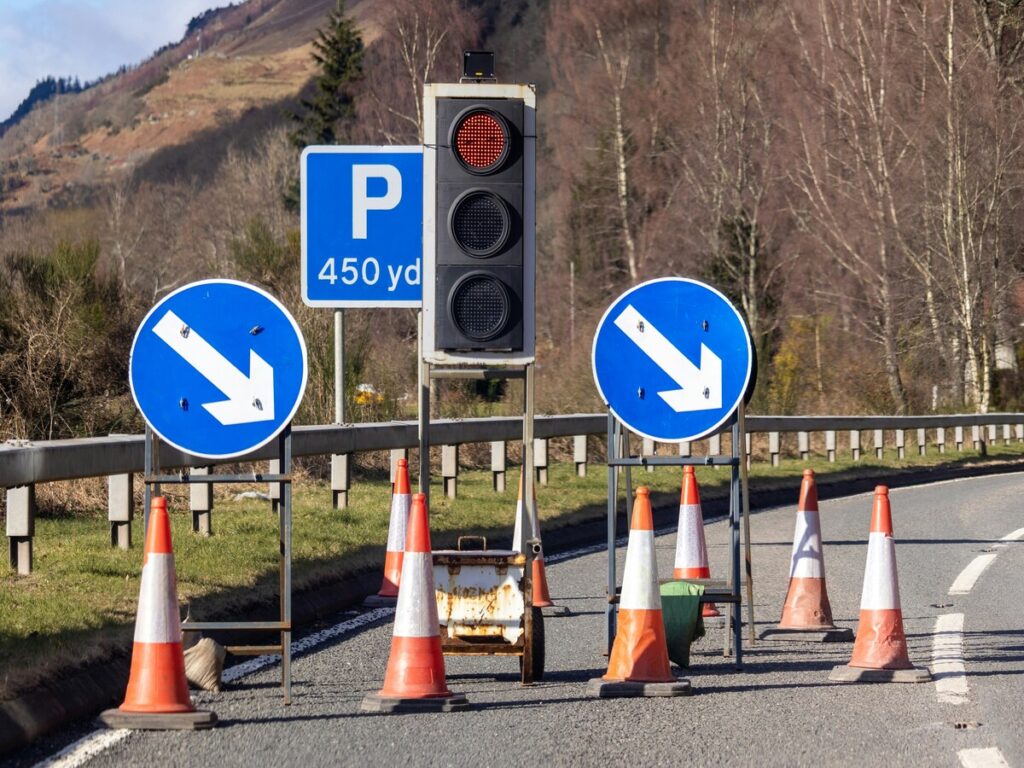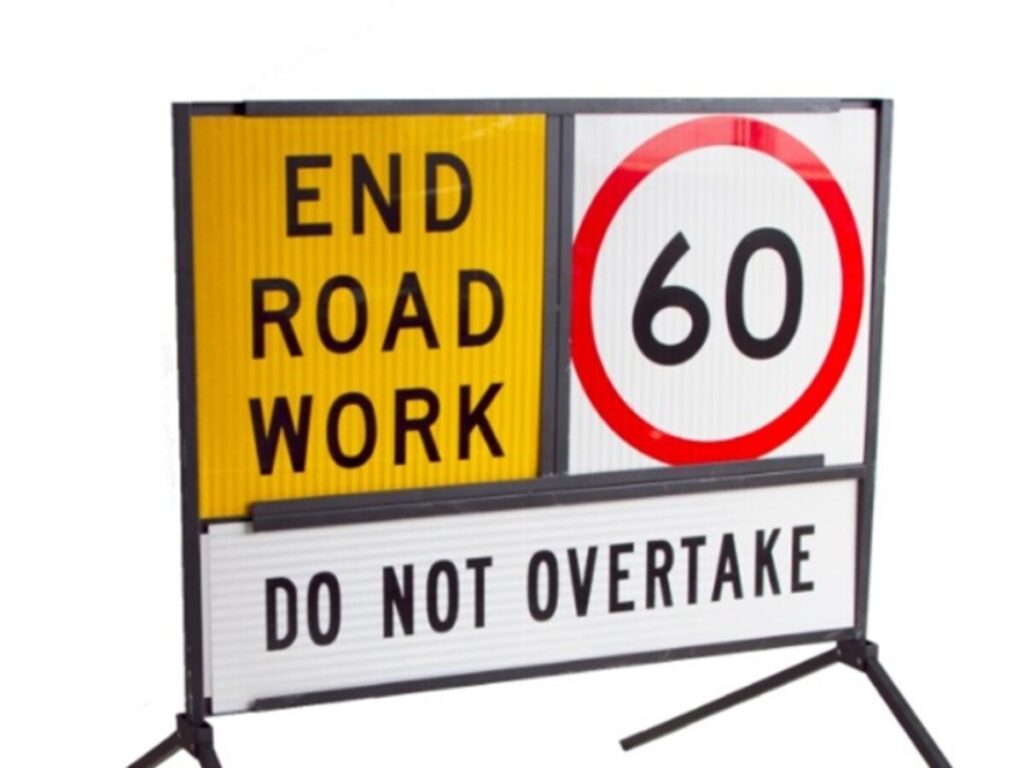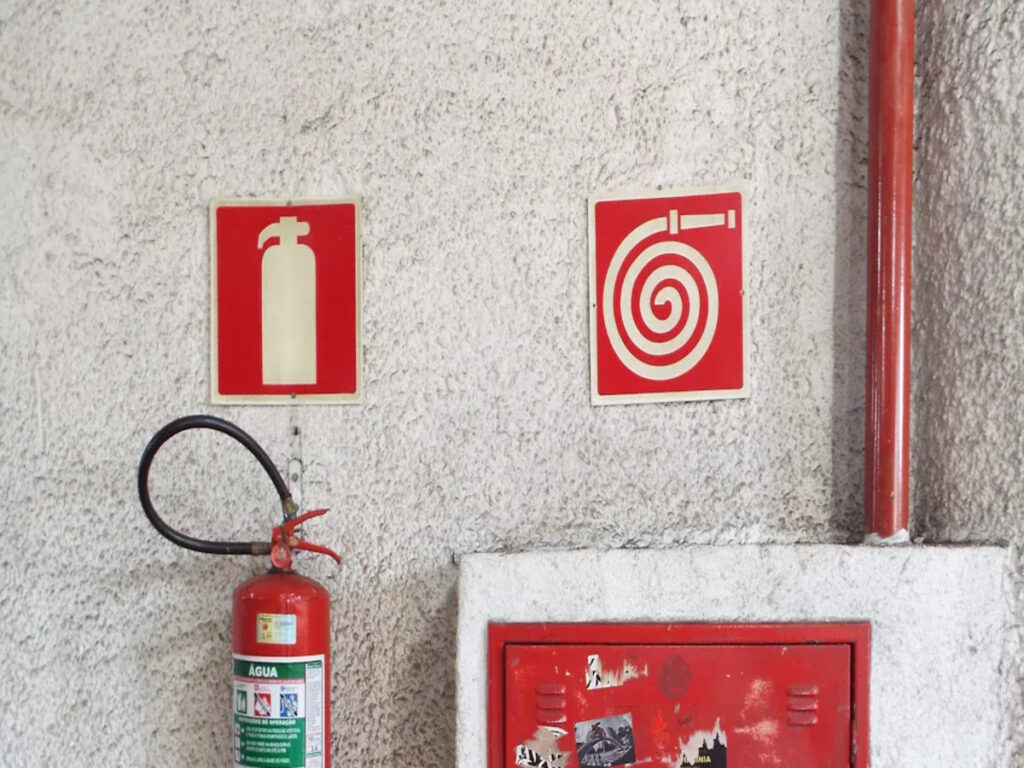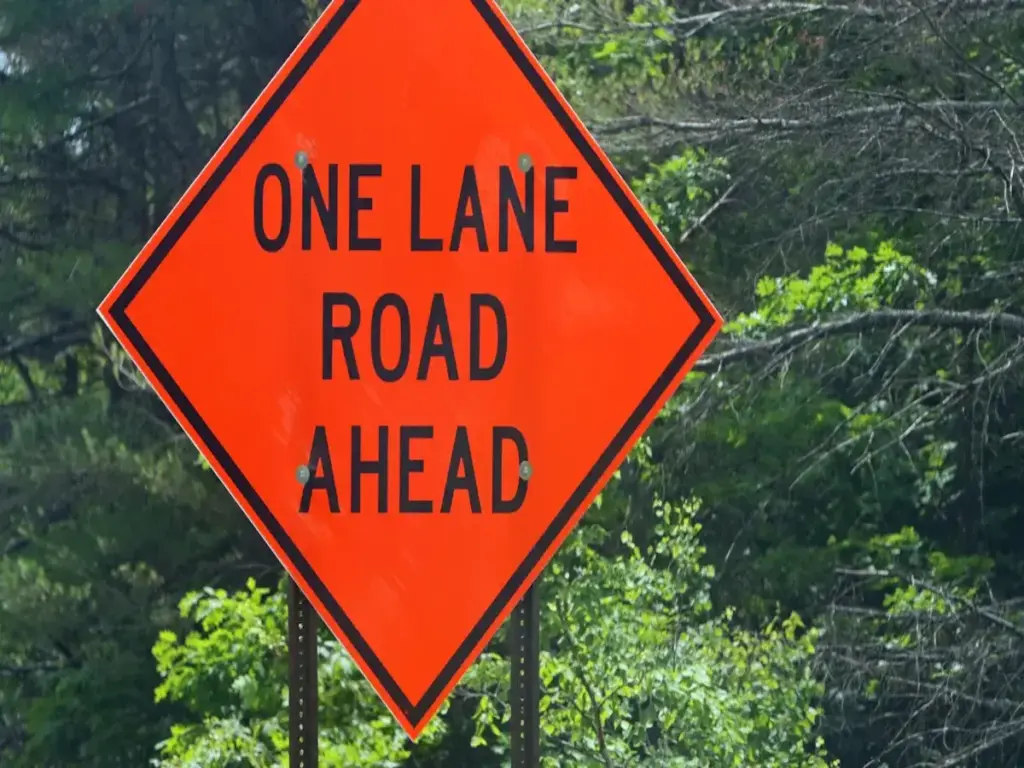
يمكن أن تشكل مناطق العمل خطورة على كل من العمال والسائقين, وكل عام, حوادث في هذه المناطق تسبب مشاكل خطيرة. ارتفعت الوفيات في مناطق العمل بنسبة 50% منذ 2013, تسليط الضوء على المخاطر المتزايدة. في 2021 وحيد, كان هناك تقريبا 105,000 تحطم و 42,000 الإصابات في هذه المناطق. بالإضافة إلى ذلك, عن 64% من بناة الطرق السريعة أفادوا بوقوع حوادث في مناطق عملهم, غالبًا ما يؤدي ذلك إلى إلحاق الضرر بالعمال أو المشاة القريبين. علامات السلامة المرورية القديمة لا تحافظ دائمًا على سلامة الناس. لا يمكن أن تتغير إشارات الطريق العادية عندما تتغير الظروف, والتحقق منها باليد يمكن أن يؤدي إلى أخطاء. تجعل هذه المشكلات من الصعب مشاركة رسائل السلامة الصحيحة بسرعة.
وهذا هو سبب أهمية رقمنة منطقة العمل. تساعد إشارات السلامة المرورية الرقمية الذكية والأنظمة الآلية في الحفاظ على وضوح اللافتات, في المكان المناسب, وتحديثها في الوقت الحقيقي. تجعل هذه التقنية الذكية مناطق العمل أكثر أمانًا وتساعد على منع الحوادث والإصابات.
في أوبترافيك, نحن ملتزمون بتعزيز السلامة المرورية من خلال الابتكار. من خلال التركيز على أحدث تقنيات المرور الذكية — بما في ذلك لوحات الأسهم المتصلة, علامات الرسائل المتغيرة (VMs), وأنظمة إدارة المرور المتكاملة - نحن نقدم الحديثة, حلول قابلة للتطوير تحول مناطق العمل التقليدية إلى مناطق أكثر ذكاءً, بيئات أكثر أمانا. مع تزايد الطلب على البنية التحتية للطرق, تواصل OPTRAFFIC قيادة الطريق في تطوير الاستجابة, أدوات تعتمد على البيانات للتحكم الديناميكي في حركة المرور.
الحاجة إلى علامات السلامة المرورية الأكثر ذكاءً

التحديات في مناطق العمل التقليدية
تعاني مناطق العمل القديمة من العديد من المشاكل التي تؤثر على السلامة. إشارات المرور العادية لا تتغير عندما تتغير الظروف. وهذا يترك السائقين غير مدركين للمخاطر المفاجئة. يستغرق التحقق من هذه العلامات يدويًا وقتًا ويمكن أن يسبب أخطاء. تعرض هذه الأخطاء العمال والسائقين للخطر.
ال وزارة النقل بالولايات المتحدة (USDOT) درست هذه المخاطر. تعمل أنظمة التحذير من قائمة الانتظار في بعض المناطق على تقليل حوادث الاصطدام الخلفية بنسبة 18% ل 45%. ولكن من دون أدوات أكثر ذكاءً, لا تزال العديد من المناطق تكافح لوقف الحوادث.
إن إدارة مناطق العمل القديمة أمر صعب للغاية أيضًا. على سبيل المثال:
| وصف المشكلة | كيف يؤثر على السلامة والكفاءة |
|---|---|
| إعداد المضلع الخاطئ يجعل الإنذارات أقل موثوقية. | التنبيهات الفائتة تعرض العمال للخطر وتبطئ العمل. |
| يجب أن تكون حدود السياج الجغرافي دقيقة للغاية. | الحدود الضعيفة تسبب تنبيهات خاطئة, المخاطرة بسلامة العمال. |
| أخطاء GPS من مشاكل تصحيح RTK. | تتسبب بيانات الموقع السيئة في حدوث إنذارات كاذبة ومخاطر تتعلق بالسلامة. |
توضح هذه المشكلات سبب فشل الأساليب القديمة في الحفاظ على مناطق العمل آمنة وفعالة.
لماذا تعتبر الرقمنة ضرورية للسلامة المرورية
تعمل رقمنة منطقة العمل على حل هذه المشكلات المستمرة باستخدام التكنولوجيا الجديدة. علامات رقمية, أجهزة الاستشعار, وتساعد الإنذارات في مراقبة المناطق في الوقت الفعلي. على سبيل المثال, يمكن للعلامات الرقمية تغيير حدود السرعة أو اقتراح تحويلات عندما تتغير حركة المرور. هذا يساعد السائقين على اتخاذ خيارات أكثر أمانًا.
وتستفيد السيارات الذكية أيضاً من الرقمنة. يتلقون تنبيهات حول مناطق العمل المقبلة, إعطاء السائقين الوقت لإبطاء.
العلامات الرقمية هي المفتاح لهذا التغيير. على عكس علامات السلامة المرورية القديمة, يظلون واضحين وصحيحين, حتى في المناطق المزدحمة. وهذا يضمن حصول السائقين دائمًا على المعلومات الصحيحة, تقليل الارتباك والحوادث.
مع رقمنة منطقة العمل, تصبح مناطق العمل أكثر أمانًا وذكاءً. يبقى كل من العمال والسائقين محميين, والعمل يسير بشكل أكثر سلاسة.
التقنيات الرئيسية في رقمنة منطقة العمل
لافتات الطرق الرقمية والأجهزة الذكية
تمثل لافتات الطرق الرقمية جزءًا كبيرًا من رقمنة منطقة العمل. هذه العلامات تحل محل القديمة, علامات ثابتة مع شاشات قابلة للتغيير. يمكنهم تحديث حدود السرعة, تحذير من إغلاق الممرات, أو اقتراح طرق جديدة. هذا يساعد السائقين على الحصول على المعلومات الصحيحة بسرعة, جعل الطرق أكثر أمانًا.
كما تعمل الأجهزة الذكية مثل أدوات التكنولوجيا والملاحة القابلة للارتداء على تحسين السلامة. التكنولوجيا القابلة للارتداء تفحص العمال’ صحة, تحذيرهم من الحرارة أو التعب. تقوم أدوات التنقل بتتبع المواقع في الوقت الفعلي, توعية الجميع بالمخاطر. معاً, هذه الأدوات تجعل مناطق العمل أكثر أمانًا وكفاءة.
| نوع التكنولوجيا | التركيز على الصناعة | الفوائد الرئيسية |
|---|---|---|
| الأنظمة القابلة للارتداء | بناء, التعدين | يتتبع صحة العامل ويحذر من المخاطر. |
| الأنظمة القائمة على AR/VR | بناء, تصنيع | يكتشف المخاطر مبكرًا باستخدام النماذج الافتراضية. |
| الأنظمة القائمة على الذكاء الاصطناعي | تصنيع, بناء, التعدين, النفط والغاز | يبقي العمال بعيدا عن المهام الخطرة, تحسين السلامة. |
| الأنظمة القائمة على الملاحة | التسجيل | يتتبع المواقع والتنبيهات حول المخاطر في الموقع. |
إن استخدام العلامات الرقمية والأجهزة الذكية يجعل مناطق العمل أكثر أمانًا وأسهل في الإدارة. تحمي هذه الأدوات العمال وتساعد السائقين على الاستمتاع برحلة أكثر سلاسة.
أنظمة المراقبة في الوقت الحقيقي
تعد أنظمة المراقبة في الوقت الفعلي أمرًا أساسيًا لرقمنة منطقة العمل. يشاهدون حركة المرور, سرعات السيارة, ووضع التوقيع في كل وقت. إذا حدث خطأ ما, مثل سقوط علامة أو زيادة حركة المرور, يتم إرسال التنبيهات على الفور. الإجراء السريع يقلل من المخاطر ويحافظ على سير العمل في مناطق العمل بشكل جيد.
تظهر الدراسات أن هذه الأنظمة تقلل من الحوادث. تعمل أجهزة مراقبة حركة المرور على قطع الاصطدامات الخلفية 45%. تعمل أنظمة التحذير من الطوابير على تقليلها بنسبة 70%. خطط مرورية أفضل, استنادا إلى البيانات في الوقت الحقيقي, تأخير أقل بنسبة 20-30%. تثبت هذه الأرقام مدى فائدة المراقبة في الوقت الفعلي للسلامة والكفاءة.
| نوع نظام المراقبة | التأثير على الاصطدامات الخلفية |
|---|---|
| أنظمة مراقبة حركة المرور | تخفيضات الأعطال بنسبة تصل إلى 45% |
| أنظمة التحذير من الطوابير | تخفيضات الأعطال بنسبة تصل إلى 70% |
| تحسين استراتيجيات التحويل | يقلل من التأخير عن طريق 20-30% |
تحافظ أنظمة الوقت الحقيقي على الإشارات الرقمية واضحة وصحيحة. فهي تساعد المديرين والسائقين على اتخاذ خيارات أفضل في مناطق العمل.
التحليلات التنبؤية في السلامة المرورية
يعمل الذكاء الاصطناعي والتحليلات التنبؤية على تغيير السلامة المرورية في مناطق العمل. يقوم الذكاء الاصطناعي بدراسة البيانات من أجهزة الاستشعار, كاميرات, وعلامات للعثور على الأنماط. يتنبأ بمشاكل مثل الاختناقات المرورية ويساعد في حلها قبل حدوثها.
الأدوات التنبؤية تحافظ أيضًا على سلامة العمال. يقومون بفحص البيانات من التكنولوجيا القابلة للارتداء لاكتشاف التعب أو التوتر. وهذا يساعد العمال على أخذ فترات راحة وتجنب الحوادث. تُستخدم أنظمة الذكاء الاصطناعي في العديد من الصناعات للحفاظ على سلامة الناس وتحسين حياتهم.
في مناطق العمل, يضمن الذكاء الاصطناعي أن تعمل العلامات وأدوات السلامة بشكل جيد. فهو يساعد على منع المشاكل ويحافظ على سلامة الجميع. إن رقمنة منطقة العمل باستخدام الذكاء الاصطناعي هي مستقبل السلامة المرورية. يساعد على حل المشكلات مبكرًا, جعل مناطق العمل أكثر ذكاءً وأمانًا.
فوائد علامات السلامة المرورية الرقمية
سلامة أفضل للعمال والسائقين
علامات السلامة المرورية الرقمية تجعل مناطق العمل أكثر أمانًا للجميع. تتغير إشارات المرور هذه بناءً على الظروف, إعطاء السائقين التحديثات الصحيحة. على سبيل المثال, يمكن أن تظهر اللافتات الرقمية حدودًا جديدة للسرعة أو تحذر من إغلاق الممرات. وهذا يساعد السائقين على اتخاذ خيارات أكثر أمانًا ويحمي العمال القريبين.
تثبت الدراسات أن الإشارات الرقمية تخفض سرعات السيارة في المناطق الرئيسية. في فنلندا, سرعات انخفضت 5-6 ميلا في الساعة, جعل المعابر أكثر أمانا. علامات الرادار في مناطق المدارس خفضت السرعات بنسبة 3.21 ميلا في الساعة, الحد من مخاطر وفاة المشاة عن طريق 22%. في كلينتون, كانساس, خفضت مقطورات الرادار السرعات بمقدار 6.1 ميلا في الساعة في موقعهم. توضح هذه الأمثلة كيف تعمل اللافتات الرقمية على تحسين السلامة لكل من السائقين والعمال.
| موقع الدراسة | انخفاض السرعة (ميلا في الساعة) | تأثير سلامة المشاة | الحد من الحوادث |
|---|---|---|---|
| فنلندا (المناطق المدرسية) | 5-6 | انخفاض كبير في سرعات المركبات | لم يذكر |
| كلينتون, كانساس | 6.1 (في مقطورة) | لم يذكر | لم يذكر |
| جنوب لندن | 1.4 | لم يذكر | لم يذكر |
| عام (علامات ديناميكية) | 5-7 | لم يذكر | لم يذكر |
| علامات ردود الفعل الرادار | 3.21 (في المناطق المدرسية) | 22% انخفاض خطر وفاة المشاة | لم يذكر |
عن طريق إبطاء السيارات وتحسين الرؤية, العلامات الرقمية تجعل مناطق العمل أكثر أمانًا للجميع.
حوادث وأخطاء أقل
تحتاج إشارات المرور القديمة إلى فحص يدوي, والتي يمكن أن تسبب أخطاء. تعمل الأنظمة الرقمية على إصلاح ذلك عن طريق أتمتة عمليات الفحص وإرسال التنبيهات. يعرف المديرون على الفور ما إذا كانت العلامات خاطئة أو مكسورة, حتى يتمكنوا من إصلاحها بسرعة. وهذا يقلل من فرصة وقوع حوادث من العلامات السيئة.
علامات ردود الفعل السرعة الديناميكية (DSFS) هي مثال جيد. تقوم هذه العلامات بتغيير الرسائل بناءً على حركة المرور. أنها تساعد السائقين على الاستجابة للتغيرات المفاجئة. في بعض الأماكن, قام نظام DSFS بخفض حوادث الاصطدام الخلفية 45%. أدت أنظمة التحذير من قائمة الانتظار إلى تقليل هذه الأعطال بنسبة 70%. يوضح هذا كيف تمنع أدوات الوقت الفعلي وقوع الحوادث.
الأنظمة الرقمية تحمي العمال أيضًا. الأجهزة القابلة للارتداء تتبع الصحة, مثل التعب أو التوتر. يذكرون العمال بالراحة عند الحاجة. وهذا يحافظ على سلامة العمال خلال ساعات العمل الطويلة.
تواصل أوضح مع السائقين
التواصل الجيد هو المفتاح للسلامة في منطقة العمل. توفر إشارات المرور الرقمية للسائقين تحديثات دقيقة بسرعة. على عكس العلامات القديمة, الرقمية تتغير على الفور لتتناسب مع الظروف الحالية. على سبيل المثال, يمكنهم التحذير بشأن التحويلات أو إظهار حدود السرعة في الوقت الفعلي.
تعمل علامات الأمان هذه أيضًا مع أدوات التنقل, إعطاء السائقين تحديثات مفصلة. السيارات الذكية تحصل على التنبيهات مباشرة, مساعدة السائقين على إبطاء أو تبديل الممرات بأمان. يقلل هذا التواصل الواضح من الارتباك ويساعد السائقين على اتخاذ خيارات أفضل.
من السهل أيضًا رؤية العلامات الرقمية في الأحوال الجوية السيئة أو في الليل. تضمن شاشات العرض الساطعة ظهور التحذيرات في الظروف الصعبة. وهذا يقلل من مخاطر الحوادث ويحافظ على حركة المرور بسلاسة.
نصيحة: لا تعمل الإشارات الرقمية على تحسين التواصل فحسب، بل تعمل أيضًا على بناء الثقة من خلال تقديم تحديثات موثوقة.
الكفاءة التشغيلية وتوفير التكاليف
أنظمة المرور الرقمية تجعل الطرق أكثر أمانًا وتوفر المال. إنهم يقللون من العمل اليدوي ويسرعون المهام. وهذا يساعد على استخدام الموارد بشكل أفضل, مع أخطاء أقل وإصلاحات أسرع.
إحدى الفوائد الكبيرة هي تقليل الحاجة إلى إجراء فحوصات يدوية. تقوم الأنظمة الآلية بمراقبة الإشارات الرقمية للتأكد من أنها تعمل وأنها في المكان الصحيح. وهذا يعني رحلات أقل للعمال, توفير الوقت والوقود. على سبيل المثال, الاستغناء عن الورق أنقذ التصنيع الإمبراطوري $6,500 سنة وجعل العمال أكثر إنتاجية.
تعمل العلامات الرقمية أيضًا على تحسين تدفق حركة المرور. يتكيفون بسرعة مع التغييرات, تقليل التأخير. أدوات مثل الذكاء الاصطناعي و التعرف الضوئي على الحروف (التعرف البصري على الحروف) المساعدة عن طريق قطع أخطاء إدخال البيانات. على سبيل المثال, تقوم الأنظمة الآلية بفحص المستندات بشكل أسرع وأكثر دقة, توفير الوقت للعمل المهم.
الأموال التي تم توفيرها تتجاوز مجرد العمليات. تم إنقاذ مستشفى باركلاند $1.2 مليون خلال عامين باستخدام النماذج الرقمية. وفرت الشركات القانونية حوالي 150 ألف جنيه إسترليني سنويًا من خلال العثور على المستندات بشكل أسرع واتباع القواعد بشكل أفضل. توضح هذه الأمثلة كيف تساعد الأدوات الرقمية العديد من الصناعات, بما في ذلك إدارة حركة المرور.
تعمل الأنظمة الرقمية أيضًا على تحسين الاتصالات واتخاذ القرارات. تساعد البيانات في الوقت الفعلي من اللافتات والشاشات على حل المشكلات بسرعة. وهذا يقلل من وقت التوقف عن العمل ويحافظ على سير الأمور بسلاسة. إنه يوفر المال ويجعل مناطق العمل أفضل للسائقين والعمال.
يعد استخدام الأدوات الرقمية في مناطق العمل أمرًا ذكيًا وضروريًا. أنها تجعل إدارة حركة المرور أكثر أمانا, أسرع, وأكثر بأسعار معقولة. تحتاج المشاريع الحديثة إلى هذه التكنولوجيا لكي تنجح.
الاستخدامات الواقعية لرقمنة منطقة العمل
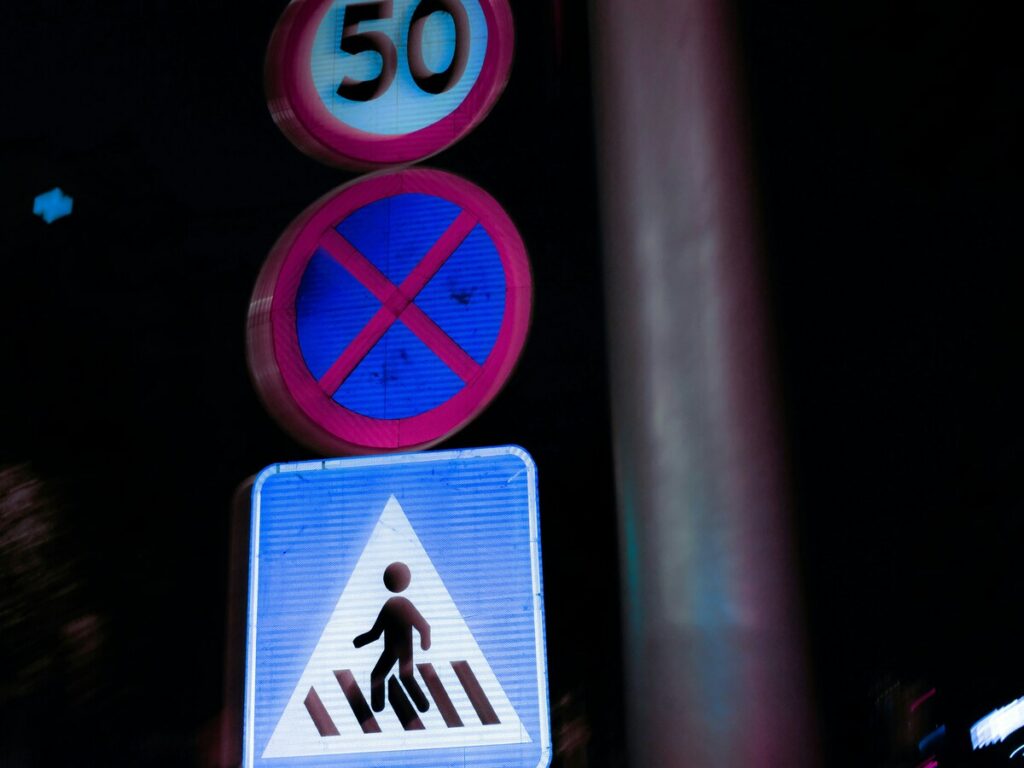
مثال: مواقع البناء الأكثر أمانا
تصور موقع بناء مزدحمًا بالعمال والمركبات في كل مكان. غالبًا ما تفشل أساليب التحكم في حركة المرور القديمة في التعامل مع مثل هذه الفوضى. تعمل رقمنة منطقة العمل على تغيير ذلك باستخدام التنبيهات الذكية والتحديثات المباشرة.
في تكساس, استخدمت شركة بناء أنظمة المرور الذكية. أظهرت اللافتات الرقمية حدود السرعة المحدثة وإغلاق الممرات. أعطت أجهزة الاستشعار تنبيهات في الوقت الحقيقي حول المركبات القريبة. هذه الأدوات تقلل الحوادث 30% في عام واحد.
كما ساعدت التكنولوجيا القابلة للارتداء العمال على البقاء آمنين. وحذرتهم الأجهزة من التعب أو مخاطر الحرارة. استخدم المديرون البيانات الحية لضبط جداول العمل, تحسين السلامة.
يوضح هذا المثال كيف تجعل التكنولوجيا مناطق البناء أكثر أمانًا. الأدوات الذكية تحمي العمال وتحافظ على تدفق حركة المرور بسلاسة.
مثال: أعمال الطرق الحضرية الأكثر أمانًا
تواجه المدن مشاكل فريدة في أعمال الطرق. حركة المرور الكثيفة والشوارع الضيقة تجعل المناطق محفوفة بالمخاطر. قامت مدينة في كاليفورنيا بحل هذه المشكلة من خلال رقمنة منطقة العمل.
وأضافوا لافتات رقمية توضح التحويلات وإغلاق الممرات. حصل السائقون على تحديثات من خلال تطبيقات الملاحة, تجنب الاختناقات المرورية. هذا القطع يؤخر 25% وتحسين السلامة للجميع.
جعلت أنظمة التحذير من قائمة الانتظار التحكم في حركة المرور أفضل. قامت هذه الأنظمة بتتبع السرعات وتحذير السائقين من التوقف المفاجئ. انخفضت حوادث الاصطدام الخلفية 40% في ستة أشهر.
ساعد الذكاء الاصطناعي أيضًا من خلال دراسة أنماط حركة المرور. وتنبأ بأوقات مزدحمة, لذلك تم العمل خلال ساعات أكثر هدوءًا. أدى هذا إلى تقليل الاضطرابات وجعل الطرق أكثر أمانًا.
توضح هذه الأمثلة كيف تعمل الرقمنة على تحسين أعمال الطرق في المناطق الحضرية. الأدوات الذكية والتحديثات المباشرة تجعل المناطق أكثر أمانًا وكفاءة.
مستقبل رقمنة منطقة العمل
الاتجاهات الناشئة في مناطق العمل الذكية
تعمل مناطق العمل الذكية على تغيير كيفية إدارة أعمال الطرق. تستخدم هذه المناطق أدوات متقدمة مثل الإشارات الرقمية و مستشعرات إنترنت الأشياء لتحسين السلامة. على سبيل المثال, تعمل العلامات الرقمية الآن مع منظمة العفو الدولية للتكيف مع التغيرات المرورية. وهذا يساعد السائقين على الحصول على التحديثات في الوقت الحقيقي, تقليل الارتباك والحوادث.
الحوسبة السحابية يحدث أيضًا فرقًا كبيرًا. يعالج البيانات بشكل أسرع, مساعدة أنظمة المرور على الاستجابة بسرعة للمشاكل. مستشعرات إنترنت الأشياء جمع بيانات حركة المرور, مساعدة المديرين على اتخاذ قرارات أفضل. تعمل هذه الأدوات على جعل الطرق أكثر أمانًا وتشجع على إنشاء مناطق عمل أكثر ذكاءً في جميع أنحاء العالم.
| وصف الأدلة | الآثار المترتبة على نمو السوق |
|---|---|
| علامات رقمية مع منظمة العفو الدولية تحسين السلامة والكفاءة. | المزيد من مناطق العمل الذكية ونمو السوق. |
| البيانات في الوقت الحقيقي تعمل على تحسين إدارة حركة المرور. | تدفق أفضل لحركة المرور وزيادة الطلب على الأدوات الذكية. |
| الحوسبة السحابية يسرع استجابات التحكم في حركة المرور. | تعمل الحلول الأسرع على تعزيز استخدام النظام الرقمي. |
| مستشعرات إنترنت الأشياء تحسين القرارات المرورية. | الخيارات القائمة على البيانات تجتذب الاستثمارات في المناطق الذكية. |
| التعلم الآلي يتنبأ بأنماط حركة المرور. | التخطيط الأكثر ذكاءً يدعم التوسع في السوق. |
توضح هذه الاتجاهات كيف تعمل مناطق العمل الذكية على تحسين السلامة المرورية والكفاءة للجميع.
التحليلات التنبؤية وتكامل الذكاء الاصطناعي
منظمة العفو الدولية والأدوات التنبؤية تجعل مناطق العمل أكثر أمانًا. يدرسون البيانات الماضية والحية للتنبؤ بالمخاطر ووقف الحوادث. على سبيل المثال, منظمة العفو الدولية يمكن اكتشاف المخاطر مثل العلامات في غير محلها أو المناطق غير الآمنة في الوقت الحقيقي.
منظمة العفو الدولية يتحقق أيضًا من المخاطر ويضمن اتباع قواعد السلامة. يقوم بإنشاء لوحات معلومات للتنبؤ بظروف الموقع, المساعدة في التخطيط لمشاريع أكثر أمانًا. وإليك كيف منظمة العفو الدولية يحسن مناطق العمل:
- جمع البيانات: يجمع معلومات السلامة من أجهزة الاستشعار والكاميرات.
- تحليل البيانات: يجد أنماطًا في مخاطر المرور والسلامة.
- النمذجة التنبؤية: يتنبأ بالمشاكل المستقبلية لتجنب الحوادث.
- تنبيهات في الوقت الحقيقي: يحذر من المخاطر على الفور.
| نوع التقدم | وصف |
|---|---|
| الكشف عن المخاطر في الوقت الحقيقي | منظمة العفو الدولية يكتشف المخاطر قبل أن تصبح خطيرة. |
| تقييم المخاطر | منظمة العفو الدولية يقيس المخاطر ويقترح الحلول. |
| مراقبة قواعد السلامة | منظمة العفو الدولية يتحقق من العتاد المناسب والأخطاء الوشيكة. |
| لوحات معلومات السلامة | منظمة العفو الدولية يتنبأ بمخاطر الموقع, المساعدة في التخطيط الأكثر أمانًا. |
يضمن استخدام الأدوات التنبؤية بقاء مناطق العمل آمنة وفعالة, حتى في المواقف الصعبة.
الاستدامة والحلول الصديقة للبيئة
إن مناطق العمل الذكية ليست أكثر أمانًا فحسب، بل إنها أكثر مراعاة للبيئة أيضًا. عن طريق الحد من الشيكات اليدوية والسفر, أنها تخفض الانبعاثات. على سبيل المثال, تعمل مراقبة اللافتات الآلية على تقليل استخدام الوقود والتلوث.
تتتبع مقاييس الاستدامة مدى صديقة هذه الأدوات للبيئة. يتم قياس استهلاك الطاقة بالكيلوواط / ساعة (كيلو واط ساعة), يوضح مقدار الطاقة المستخدمة. البصمة الكربونية, طن من ثاني أكسيد الكربون (ثاني أكسيد الكربون), يوضح مقدار تقليل الانبعاثات.
| متري | وصف |
|---|---|
| استخدام الطاقة | تقاس في كيلو واط ساعة, إظهار القوة التي تستخدمها الأدوات الرقمية. |
| بصمة الكربون | تقاس في ثاني أكسيد الكربون, عرض الانبعاثات التي تم حفظها بواسطة المناطق الذكية. |
باستخدام الممارسات الخضراء, أنت تساعد الكوكب وتحسن السلامة المرورية. تعمل هذه الحلول على توفير الطاقة وتجعل إدارة مناطق العمل أكثر كفاءة.
تعمل رقمنة منطقة العمل على تغيير الطريقة التي نحافظ بها على سلامة الطرق. فهو يساعد على حماية العمال والسائقين عن طريق الحد من الحوادث ومشاركة التحديثات الواضحة. على سبيل المثال, لم يتعرض نظام Haas Alert الموجود على طريق Pennsylvania Turnpike لأي حوادث مع مركبات الطوارئ 2020. كما تسببت التنبيهات الرقمية في حدوث أعطال 90% أقل احتمالا وتقليل الكبح المفاجئ 80%. حتى أن هذه التنبيهات أدت إلى إبطاء حركة السيارات 25% بعد إرسالها.
تكمن قوة إشارات السلامة المرورية الرقمية في تحديثاتها السريعة. فهي تتكيف مع التغييرات في الوقت الفعلي وتزود السائقين بالمعلومات الصحيحة. هذه التكنولوجيا تنقذ الأرواح وتجعل أعمال الطرق أكثر كفاءة.
يمكنك المساعدة في جعل أعمال الطرق أكثر ذكاءً وأمانًا. باستخدام هذه الأدوات, يمكنك تحسين تدفق حركة المرور والحفاظ على سلامة الجميع. ابدأ في استخدام رقمنة منطقة العمل الآن لبناء مستقبل أكثر أمانًا للجميع.
التعليمات
ما هي رقمنة منطقة العمل?
تستخدم رقمنة منطقة العمل أدوات ذكية مثل الإشارات الرقمية وأجهزة الاستشعار. فهو يستبدل الأساليب القديمة بأنظمة تقدم تحديثات مباشرة. تعمل هذه التحديثات على جعل مناطق العمل على الطرق أكثر أمانًا للعمال والسائقين.
كيف تعمل إشارات المرور الرقمية على تحسين السلامة?
تتغير علامات السلامة المرورية الرقمية بناءً على الظروف في الوقت الفعلي. أنها تظهر التحديثات مثل حدود السرعة أو المنعطفات. وهذا يساعد السائقين على تجنب الحوادث واتخاذ خيارات أكثر أمانًا. كما أنها تظل صافية في الطقس السيئ أو في الليل.
هل يمكن لرقمنة منطقة العمل تقليل التكاليف؟?
نعم! تقلل الأنظمة الآلية من عمليات الفحص اليدوي, توفير الوقت والوقود. أنها تساعد الفرق على التركيز على المهام الهامة. توفر هذه التغييرات المال لشركات البناء ومديري المرور.
كيف يساعد الذكاء الاصطناعي في سلامة منطقة العمل?
يدرس الذكاء الاصطناعي البيانات الواردة من أجهزة الاستشعار والكاميرات للعثور على المخاطر. يحذر من المخاطر ويساعد على منع وقوع الحوادث. يتحقق الذكاء الاصطناعي أيضًا من صحة العمال ويضمن وضع العلامات بشكل صحيح.
هل رقمنة منطقة العمل صديقة للبيئة؟?
نعم! فهو يقلل من السفر لإجراء عمليات التفتيش ويحسن تدفق حركة المرور. وهذا يقلل من استخدام الوقود ويقلل الانبعاثات. تستخدم الأنظمة الآلية أيضًا طاقة أقل, مساعدة البيئة.
نصيحة: تجعل رقمنة منطقة العمل الطرق أكثر أمانًا وتساعد الكوكب.

